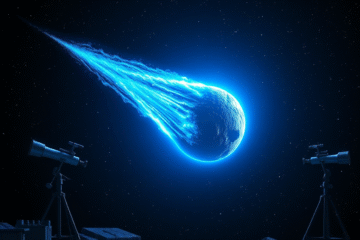Asteroid 2025 TF Passes Near Earth
Small Asteroid is the designation we receive for objects like 2025 TF, which recently passed surprisingly close to Earth.
In this article, we will explore in depth the remarkable approach of this asteroid, its dimensions, and why it poses no risk to our safety.
Additionally, we will discuss the importance of accurately tracking small asteroids, a significant challenge due to their tiny scale and the vastness of space.
The observation of 2025 TF not only highlights current tracking technology, but also the importance of understanding objects that may approach our planet.
Historic Close Approach of Asteroid 2025 TF
In a historic close approach, asteroid 2025 TF crossed the skies over Antarctica, passing within a record distance of 428 km of the Earth's surface.
This remarkable event occurred on October 1, 2025, and is one of the closest passages ever recorded of a celestial object of this type.
The asteroid's proximity to our planet highlights the importance of tracking accuracy of small asteroids, something that the scientific community seeks to continually improve.
The magnitude of this approach sparks renewed interest in methods of identifying and monitoring near-Earth objects.
Identifying asteroids of varying sizes is a significant challenge, given the technical resources required for their detection.
Fortuitously, the passage of 2025 TF occurred without risks to terrestrial life, reinforcing that, although a relevant alert for continuous vigilance, science allows us to predict and prevent possible threats in an uncertain future.
The potential impact of an asteroid on the planet's safety drives the need to develop innovative technologies.
Given progress in astronomy and the occurrence of events such as the recent passage of 2025 TF, it is expected that the ability to respond to approaching space objects will be expanded, ensuring greater protection for our terrestrial environment.
Physical Properties of 2025 TF
Asteroid 2025 TF is attracting interest thanks to its estimated dimensions, which vary from 3 the 9 meters in diameter.
This feature makes it comparatively small when aligned with other larger celestial bodies.
The significant size difference between asteroids is crucial to understanding the impact potential on Earth, since smaller objects like 2025 TF do not cause considerable damage upon entering the Earth's atmosphere.
Furthermore, the accuracy in tracking such tiny objects represents a remarkable feat in the field of astronomical observations. **List of 2025 TF's dimensional properties:**
- Minimum diameter: 3 m
- Maximum diameter: 9 m
This precision allows us to predict their trajectories in advance, minimizing concerns about a possible collision with Earth.
For more information, visit the details about asteroids.
This exemplifies how the study of small asteroids can illuminate our understanding of the dynamics of space.
Planetary Risk and Security Assessment
Asteroid 2025 TF passed at an impressively close distance to Earth.
However, does not pose a risk to the planet.
With a diameter of only 9 meters at most, it does not meet the criteria for a real threat, which generally considers objects at least 150 meters in diameter.
Upon entry into the atmosphere, objects of this size do not cause significant damage, as most of them disintegrate due to friction and pressure.
Observing these features strengthens the security of our planetary defense systems, benefiting from the precise tracking that NASA and the European Space Agency have been developing in recent years.
Through these systems, it was possible to rule out any possibility of impact or considerable damage to our planet.
The interaction of asteroids like 2025 TF with the atmosphere illustrates how effective planetary defense studies are.
This effectiveness has been demonstrated on several occasions, such as the successful DART mission, designed to deflect small space threats.
Even in cases of extreme close proximity, such as this asteroid, accurate calculation of future orbits helps us mitigate concerns.
For more information on asteroids, check out this interesting article in Olhar Digital.
Thus, planetary security remains one of the priorities of the scientific community, ensuring that no significant threat is underestimated.
Tracking Small Asteroids: Advances and Challenges
The observation of small asteroids like 2025 TF represents a significant advance in astronomy.
Detecting such small objects is a huge challenge due to their low brightness and the starry background of the sky that often obscures them.
However, advances in technology and observation methods have increased our tracking accuracy of these objects.
With the use of more powerful telescopes and more sophisticated tracking systems, scientists are now able to predict the paths of these asteroids in impressive detail.
Examples of such advances can be seen in the NASA mission discussed in this video about NASA's mission, which deflected asteroids.
Furthermore, international collaboration and data sharing have been vital.
New techniques, such as high-precision astrometry and photometry, allow us to identify and analyze the trajectories of smaller asteroids.
These techniques, combined with AI algorithms, help decipher movement patterns in advance, minimizing the risk of surprise.
To learn more about how these efforts are underway, you can read this article on how the astronomers are improving techniques.
| Challenge | Advance |
|---|---|
| Low brightness | Most powerful telescopes |
| Predictability of orbits | Tracking accuracy |
In summary, the passage of asteroid 2025 TF is a reminder of the need for continued vigilance over near-Earth objects.
With advancing tracking technology, we can ensure the safety of our planet from small asteroids and other potential space hazards.



0 Comments